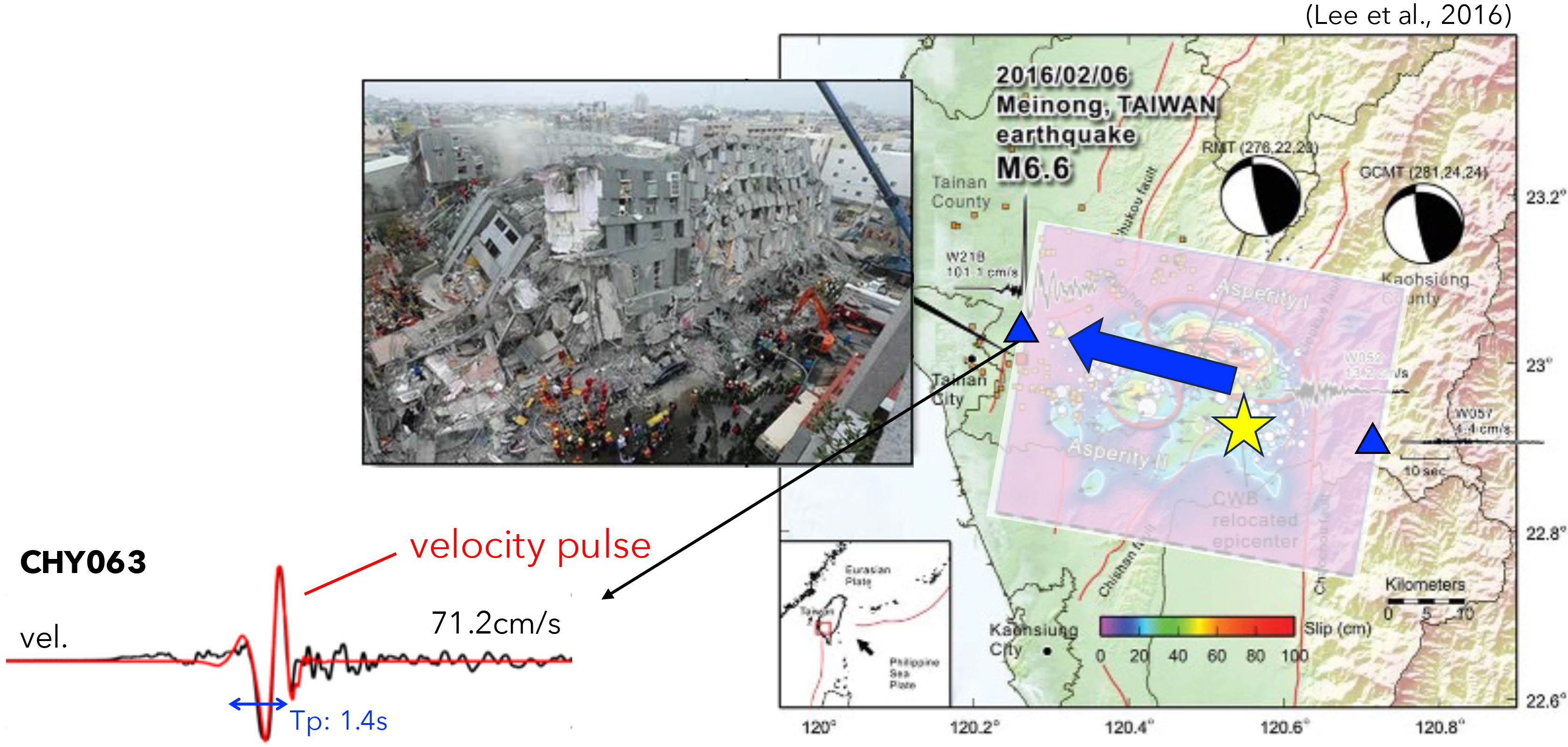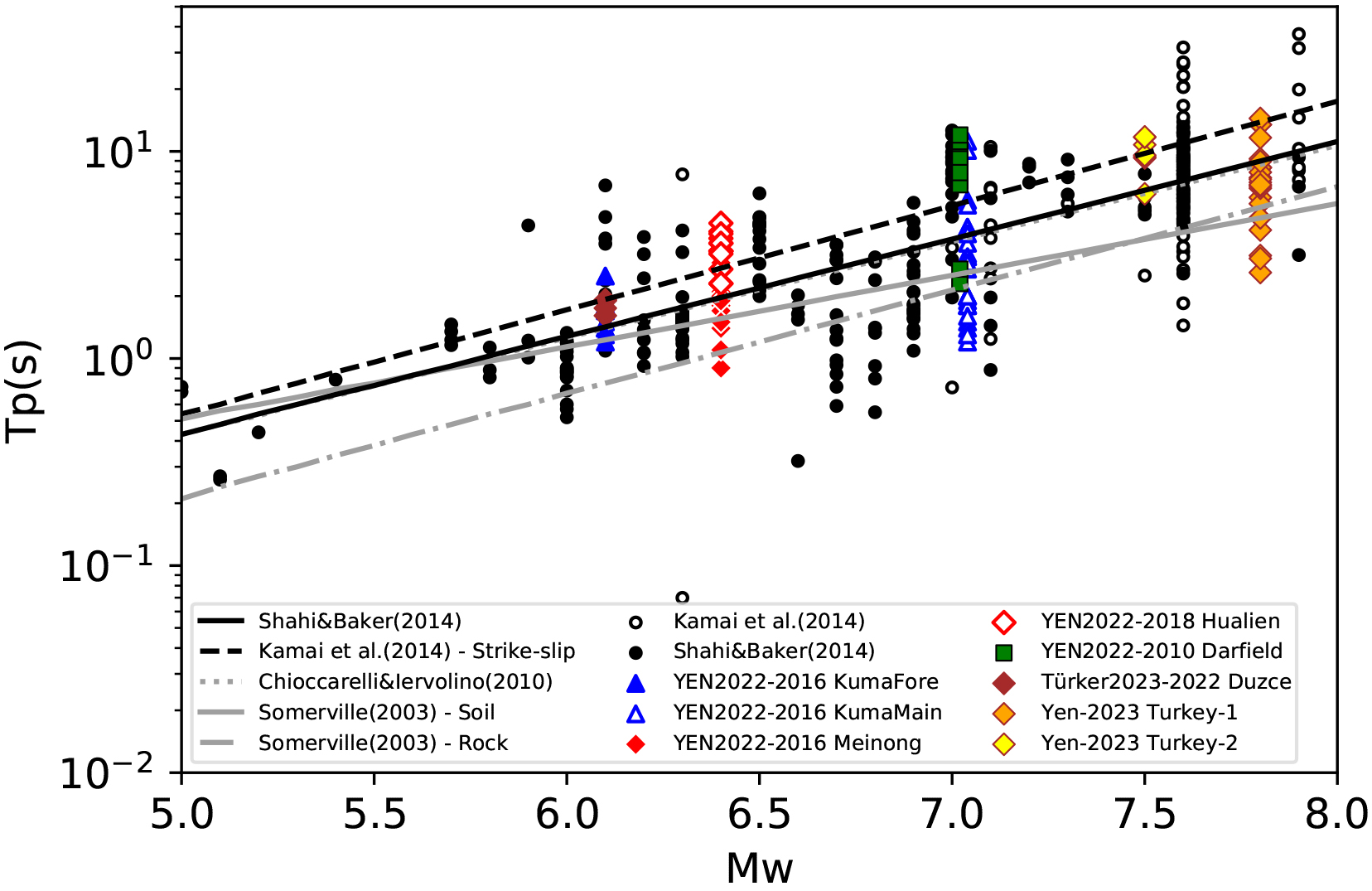Strong Velocity Pulses in Earthquakes: Insights and Impacts
Ming-Hsuan Yen and Fabrice Cotton
German Research Centre for Geosciences, Potsdam, Germany
Earthquake ground motions characterized by long durations and high shaking amplitudes, known as strong velocity pulses, can cause extensive damage to buildings and structures, especially if their natural periods resonate with the pulse period. When earthquakes occur with the directivity effects, they produce amplified velocity amplitudes at certain periods, increasing the risk of resonance-induced structural damage. Even moderate earthquakes can cause extensive destruction under such conditions, as demonstrated by the 2016 Meinong earthquake in Taiwan (see Figure 1). Therefore, understanding the periods and velocity amplitudes of such pulses is critical for earthquake structural engineering.
Strong velocity pulses are typically observed at sites near the fault where the earthquake rupture propagates toward the station. These pulses are primarily caused by forward directivity effects, often referred to as directivity pulses (Somerville, 2003; Bray & Rodriguez-Marek, 2004). However, some studies have also identified another mechanism known as fling-step pulses, which result from tectonic deformation caused by rupture dynamic process along the fault zone. This type of pulse results in a spatially distributed static offset (Kamai et al., 2014). In some cases, both types of pulses – directivity and fling-step – can occur simultaneously at a station. To better isolate the impact of directivity effects, we proposed a strategy to remove the fling-step (static offset) from the displacement time history, allowing a clearer focus on the dynamic characteristics of directivity pulses (Yen et al., 2022).
In our recent studies, we applied the wavelet analysis of Shahi and Baker (2014) to characterize directivity pulses from moderate but damaging earthquakes in Japan, Taiwan, New Zealand, and Turkey (Yen et al., 2022, 2024; Türker et al., 2024). The results show that while the static offset strongly affects velocity amplitudes, it has a minimal impact on pulse periods (Yen et al., 2022). Figure 2 demonstrates the relationship between directivity pulse periods and earthquake magnitude, revealing that pulse periods depend on magnitude. Furthermore, the variability of pulse periods within individual earthquakes tends to increase with larger magnitudes. This observation suggests that larger events are associated with more complex rupture processes, which significantly influence the characteristics of directivity pulses.
Overall, pulse periods range between 1 and 15 seconds, corresponding to the natural periods of tall buildings (10 to 100 floors). Such velocity pulses caused significant damage to buildings and structures during the 2023 Kahramanmara earthquake doublet. These findings suggest that the importance of incorporating velocity pulses into seismic hazard assessments and earthquake-resistant design strategies, particularly in urban areas with modern high-rise buildings.

Figure 1. The seismic and structural impact of the 2016 Meinong earthquake (M6.6) in Taiwan, which was characterized by a strong velocity pulse (adapted from Lee et al., 2016). The velocity time history at station CHY063 shows a distinct velocity pulse with a peak amplitude of 71.2 cm/s and pulse period (Tp) of 1.4 seconds.

Figure 2. Pulse periods (Tp) as a function of earthquake moment magnitude (Mw). The lines show the regressions of Shahi and Baker (2014) (black solid line), Chioccarelli and Iervolino (2010) (grey dotted line), and Somerville (2003) (grey dashed-dotted-dashed line). Black dots represent the pulses identified from the NGA-West2 database in the study of Shahi and Baker (2014). Open circles represent the fling-step pulses published by Kamai et al. (2014). Figure modified and adapted from Yen et al. (2022).
參考文獻
Bray, J. D., & Rodriguez-Marek, A. (2004). Characterization of forward-directivity ground motions in the near-fault region. Soil Dynamics and Earthquake Engineering, 24(11), 815–828. https://doi.org/10.1016/j.soildyn.2004.05.001
Chioccarelli, E., & Iervolino, I. (2010). Near‐source seismic demand and pulse‐like records: A discussion for L'Aquila earthquake. Earthquake Engineering & Structural Dynamics, 39(9), 1039–1062. https://doi.org/10.1002/eqe.987
Kamai, R., Abrahamson, N., & Graves, R. (2014). Adding Fling Effects to Processed Ground-Motion Time Histories. Bulletin of the Seismological Society of America, 104(4), 1914–1929. https://doi.org/10.1785/0120130272
Lee, S.-J., Yeh, T.-Y., & Lin, Y.-Y. (2016). Anomalously Large Ground Motion in the 2016 ML 6.6 Meinong, Taiwan, Earthquake: A Synergy Effect of Source Rupture and Site Amplification. Seismological Research Letters, 87(6), 1319–1326. https://doi.org/10.1785/0220160082
Shahi, S. K., & Baker, J. W. (2014). An Efficient Algorithm to Identify Strong-Velocity Pulses in Multicomponent Ground Motions. Bulletin of the Seismological Society of America, 104(5), 2456–2466. https://doi.org/10.1785/0120130191
Somerville, P. G. (2003). Magnitude scaling of the near fault rupture directivity pulse. Physics of the Earth and Planetary Interiors, 137(1–4), 201–212. https://doi.org/10.1016/s0031-9201(03)00015-3
Türker, E., Yen, M.-H., Pilz, M., & Cotton, F. (2024). Significance of Pulse-Like Ground Motions and Directivity Effects in Moderate Earthquakes: The Example of the Mw 6.1 Gölyaka-Düzce Earthquake on 23 November 2022. Bulletin of the Seismological Society of America, 114(2), 955–964. https://doi.org/10.1785/0120230043
Yen, M.-H., von Specht, S., Lin, Y.-Y., Cotton, F., & Ma, K.-F. (2022). Within- and Between-Event Variabilities of Strong-Velocity Pulses of Moderate Earthquakes within Dense Seismic Arrays. Bulletin of the Seismological Society of America, 112(1), 361–380. https://doi.org/10.1785/0120200376
Yen, M.-H., Türker, E., Ulrich, T., Marchandon, M., Gabriel, A. A., & Cotton, F. (2024). An analysis of directivity pulses using empirical data and dynamic rupture simulations of the 2023 Kahramanmaras earthquake doublet. Earthquake Spectra. [Accepted]